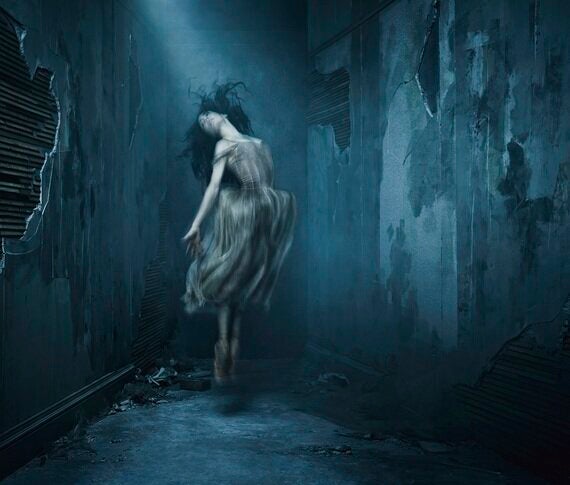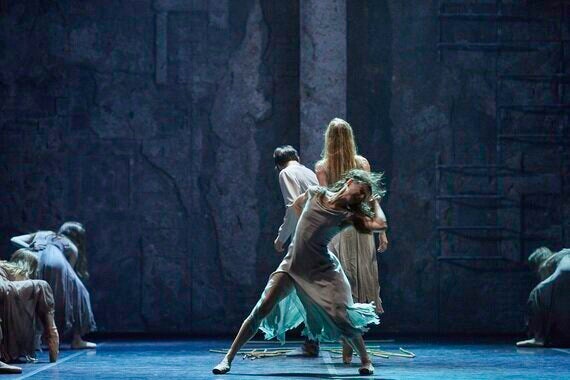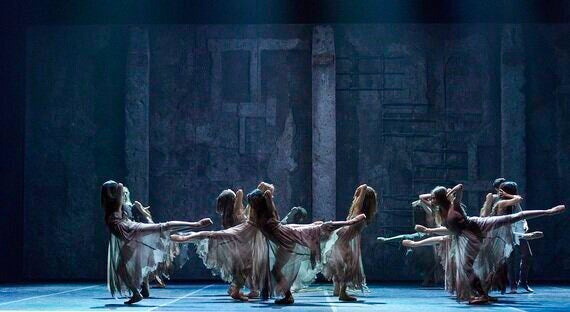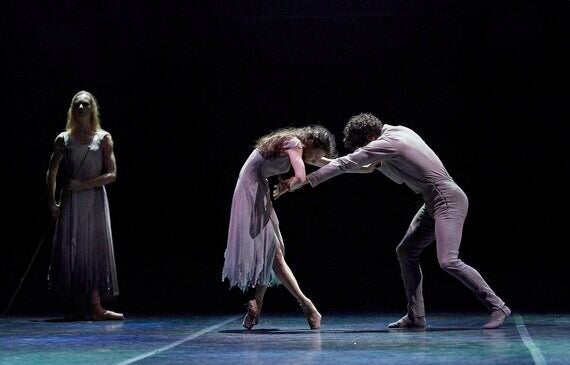
When Artistic Director of the English National Ballet, Tamara Rojo, asked the leading talent in contemporary choreography, Akram Khan, to work with her in reimagining Giselle, did she imagine that they would create a work this radical, this exceptional? Because if she did, well, what vision. For what Akram Khan's Giselle shows us is that we should not fear tackling the classics because, if done well, there is the possibility of changing everything.
This Giselle casts such a powerful, dark, gothic spell. It's utterly revolutionary and completely spellbinding. Never my favourite classical ballet, yet here this story is infused with such darkness, and richly layered with profound political themes, that it is both brilliant and intense.
Our Giselle (played by Alina Cojocaru on the night I visited) is one of a vast throng of maltreated migrant workers. A vast foreboding wall hems them in (somewhat appropriate given current events) and when they're not working factory lines, the sound of waves on a beach brings back echoes of the deaths of Chinese migrant workers in the UK as they were picking cockles on a beach.

Yet Giselle catches the eye of Albrecht (Isaac Hernández), one of the ruling clique that governs this mass of workers. Giselle is smitten too, yet their love is dashed on the rocks. The Landlords are appalled at Albrecht's choice of lover and Giselle winds up dead by murky means.
This was all by the interval and, even by then, you know you are watching a masterpiece. The choreography from Khan... I mean, it's something else, it really is. Powerfully emotive and brilliantly innovative, the broken spirit of the hordes emanates from the Artists of the Company as they move and flow like a surge. And Alina Cojocaru, faultless as ever, captures the tortured spirit in Giselle perfectly.
I had fears that the second half could not live up to such standards. I was wrong.
I don't think I've ever witnessed anything in contemporary dance as extraordinary as the spirit world of the Wilis - and I saw ENB's Lest We Forget. The stage is smothered in darkness, the ghosts like gothic heroines with tangled masses of long hair shrouding their faces, come forth like an army of furies.

The rage of the Wilis is intoxicating. The ferocious stamping of their sticks in hypnotic rhythm, their wrath, their malevolence... There is black magic in the air. The audience as one were forward in their seats, completely hypnotised, utterly immersed in this dark sea of revenge and anger.
Never did I ever think I would be so absorbed by Giselle, for there has always been a hurdle for me when it comes to this ballet, and that is largely due to the woman herself. Usually a rather pathetic creature; a woman who loved too much, for sure. Spurned by her rich lover, she usually either gives herself a heart attack or commits suicide, only to look out for her lover in death far more than he ever looked out for her in life.
Hardly a sympathetic character. Yet here too, this radical reworking has challenged itself to find Giselle a better narrative. Working around the obscurity in Giselle's death, here there is the shadow of a murder. The rich Landlords, concerned that one of their own could be seen with someone of such social status, seem to have Giselle knocked off on the sly whilst her lover's attention is diverted.
Well, well, well... Now we have not just a character who has been wronged in a far more meaningful way, we also have the political subtext of the unchecked power of the elites.

And it is a more spirited Giselle we see amongst the ghosts. Here, she is clearly a light to their darkness, Alina Cojacaru portraying Giselle as tangle of fear and confusion, and defiance and strength. And her battle with Myrtha, Queen of the Wilis (the sublime Stina Quagebeur) climaxes with one of the finest pas-de-deux you could imagine in contemporary ballet as Alina Cojocaru and Isaac Hernández have their final dance together - Giselle and Albrecht reunited one last time before she must return to her grave, and he to the world of the living. Passion, tenderness and agile acrobatics blend together in a superb finale.
Plaudits will go to Akram Khan for this production - and rightly so as, what vision, what talent - but there must also be a special mention for Vincenzo Lamanga for Music, and Marcus Hyde for Sound. The soundtrack is pulsating - deep and, at times, unrelenting. Yet there are sudden breaks... periods of silence, static noise, or just the rolling sound of waves. It is superb and a key factor in the fully-formed creation of this new world for Giselle.
This is ground-breaking work from Akram Khan, Tamara Rojo and the English National Ballet. Such massive risk taken, and what a payoff. A marker for what is possible. How others can respond to this game-changer, I don't know. Utterly phenomenal.
Sadler's Wells, London, to November 19, 2016. (Returning September 2017)
Image Credits:
1. Akram Khan's Giselle for English National Ballet. Dancer; Tamara Rojo © Jason Bell
2. Alina Cojocaru in Akram Khan's Giselle © Laurent Liotardo
3. English National Ballet in Akram Khan's Giselle © Laurent Liotardo
4. Stina Quagebeur, Alina Cojocaru and Isaac Hernandez in Akram Khan's Giselle © Laurent Liotardo